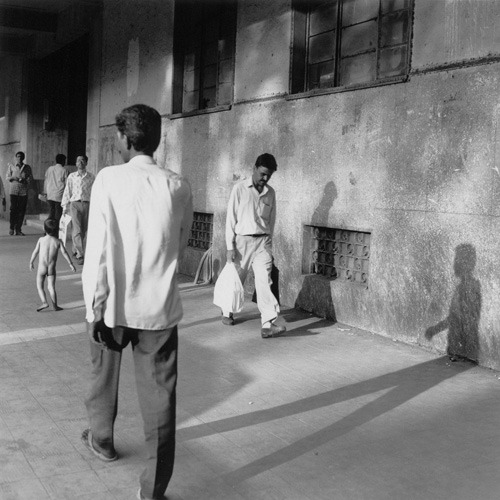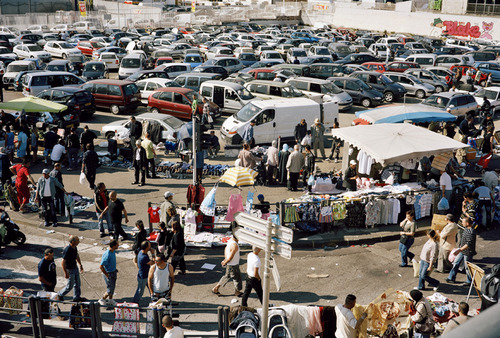Tell us about your approach to photography. How it all started? What are your memories of your first shots?
Geoffroy Mathieu (GM): I began to be seriously interested by photography in college. With my old friend Ambroise Tezenas, when we were 16, we began to photograph Paris and our friends, developing pictures in the laboratory of the college. We walked in the streets of Paris at night, discovering the possibilities of the medium. Our first masters were the humanist photographers Izis, Brassai or Doisneau. Later, we were fan of Magnum photographers and their ability to tell the story of the world. But, too afraid to choose photography as a job, I studied accountancy first and photography was just a hobby at this time. Things became more and more clear for me, so I tried to enter the school of Arles, but didn’t succeed the first time. To be more credible, I worked in Magnum agency for almost one year, this time was my real birth in photography. When I succeeded in entering the National Photographic school in Arles, I discovered a world behind Magnum and reportage…

© Geoffroy Matheiu from the series Canopée, 2009 - 2012
How did your research evolve with respect to those early day?
GM: From Magnum legendary photographers, I shifted to Walker Evans and the landscape photographers Stephen Shore, Robert Adams or Lewis Baltz. I felt closer to their ways of using photography not only as a testimony but also a description of a world changing as they exposed. My first studies were street photography in 4 different cities (NY, Mumbai, Marseille and Cairo). I gained experience there while walking in cities and building a series that tries to create a conversation about modern cities and how humans are living in them. Landscape photography arrived later in my progression when I chose a first project that dealt with the landscape around the building of the Millau viaduc. In this series I searched for landscapes of transition, fascinated by the changes that appear just as if they were installed by Land artists. I discovered there that land is a moving matter. It’s always my deep purpose, I think.

© Geoffroy Matheiu from the series ‘En ville, à la plage 1997-2000’, New York, Le Caire/Alexandrie, Bombay, Marseille
Could you please tell us about your experience with the Observatoire Photographique du Paysage? Some of this research also deals with time. What are your personal impressions about photographing the same place/landscape over the years?
GM: The Observatoire Photographic of Paysage involves the procedure of shooting the same place with the same frame each year to observe the changes. I have always been fascinated by the power of light or the time passing on a scene. A landscape is never the same, each minute, each hour, each day, imagine each year or every 10 years ! It produced very interesting corpus of pictures, to study in a technical way, but in an artistic way it produced a poetic vision of time passing. As long as you come back on the same spot each year, you begin to develop an intimate relationship just as with a good friend. For some of them, I am happy to see them each year. They become good friends. Hey landscape! What happened to you this year? What did you change? How is the light on you today? Maybe it’s better if I come back tomorrow?

© Geoffroy Mathieu from the series ’Observatoire Photographique du Paysage - Communauté de communes de la Vallée de l’Hérault’, extrait 2010 - 2011 - 2012
Tell us about the project ‘Marseille, Wild City’.
GM: The story of this project is born when I met Baptiste Lansapeze who is a writer and editor (wildproject editions). He was interested in theories on urban ecology research and deep ecology theories. I discovered those thoughts when walking in the peri-urban landscapes of Marseille and talking with him. During 4 years we began to understand why this city was a perfect place to study the relationship between nature (not only vegetation) and urbanity. He was writing an essay on urban ecology, and I was taking pictures of Marseille, not to illustrate his point of view, but to show that within Marseille nature and urban grow together in a mix.

© Geoffroy Matheiu from the series ’Marseille, Wild City’
The project ‘Marseille, Wild City’ has been selected for the new edition of the exhibition “Naturae” which is centered on the experience of space, especially through nature. Tell us about how the photographic medium is involved in the perception of space, or rather in its awareness.
GM: Photography is a good medium to understand and transmit the intelligence of a place. In a frame, you can arrange the world, make it intelligible. That is what happens when the photographer succeeds in transmitting in pictures the personal relationship he builds with the scene he saw. I consider those relationships as meetings. A meeting between an exposure, a light and a geography. This is successful when the photographer succeeds in finding the best point of view to transmit the poetry of this meeting. When you work in any project with a purpose, as with Marseille, Wild City, the challenge was to find the best point of view to express our idea of the wild and how we consider cities as part of nature. In fact, the place where a majority of homo sapiens are living.

© Geoffroy Matheiu from the series ’Marseille, Wild City’
Today we are witnessing, at least in technological societies, a huge production of images (photographs, advertising, satellite, street view, social networking and so on). A sort of daily bombardment. How do you think this affects the perception of the world by individuals?
GM: This bombardment is producing on our children a very different sense of perception, that is sure. They don’t use, look and read pictures as we do but they will develop a way of thinking about them. This is the evolution of the story of photography, we, photographers and artists, have to do our job, making intelligent pictures that give a point of view on the world. I am optimistic, I think that the more “poor” pictures will be taken and seen, the more we will need intelligent pictures. Now and more than ever, we need their glances to understand our world.

© Geoffroy Matheiu from the series ’Marseille, Wild City’
You have studied at Ecole Nationale de la Photographie d’Arles. Do you feel that is important to educate people to read images? Should we be more active in relation to what we are exposed to?
GM: Of course, we have to do this job at school, to educate children to read pictures, but they see so many pictures that they develop an experience that we didn’t have. There will be experts ! In this stream of pictures, we need more places that show pictures with a real point of view : Museums, websites or books, whatever…
Some images of the series ‘Marseille, Wild City’ are included, among others taken in Edinburgh and Tangier, in your recent book Geum Urbanum? Could you please introduce us to this special edition.
GM: After my investigation of Marseille, I wanted to compare the relationships between vegetation and cities in other towns. I chose Tangiers and Edinburgh. In Tangiers I photographed the growing city in the countryside around and in Edinburgh I tried to show the peaceful and Anglo-Saxon way of including nature in the cities. At the end, I realized how much, through my exposures, we can find the same situations in different places. With triptychs I put together pictures of similar types of landscape found in those cities.


© Geoffroy Matheiu, book “Geum Urbanum”
Projects that you are working on and plans for the future?
GM: A part of my work is made by walking, I introduce more and more the walk in my creative process. I did it without really thinking of it in the project Dos a la mer, which was a series of promenades. I was walking in the cities with no protocol, as a perambulation. More recently, in the project of Paysages Usagés, that I made with Bertrand Stofleth on the GR2013. We walked on a trail made for discovering the peri-urban of the metropole of Marseille.
In 2015 I worked with SAFI, a collective of two artists working on wild urban plants. We trace a new trail in the souvenir of the rurality of Marseille. I present those pictures in a diaporama, showing our research, and our walks.
---
LINKS
Geoffroy Mathieu
France
share this page